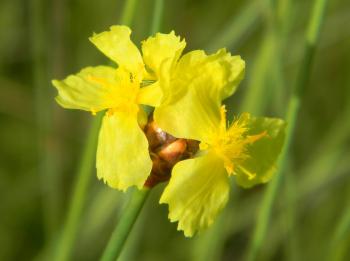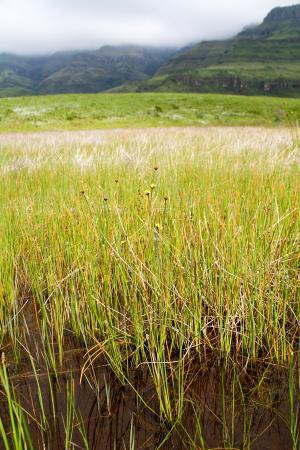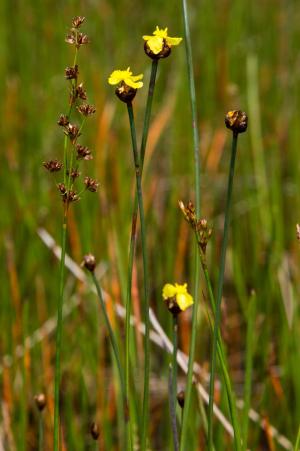Xyris capensis
Xyris capensis Thunb.
Family: Xyridaceae
Common names: Cape yellow-eyed grass, common xyris (Eng.); hloho-tsa-makaka, kaka-hlothona (Sesotho); umuzi (SiSwati); udoyi oluncane (isiZulu)
Introduction
Xyris capensis is a perennial grass-like plant growing from a more or less creeping rhizome. Its yellow flowers are clustered in a roundish spike which is held high upon a wiry, leafless peduncle.

Description
Description
Xyris capensis is a rush-like herbaceous plant, mostly perennial but occasionally annual, up to 60–300 mm tall, which occurs in clumps. It possesses a weak rhizome. The grass-like leaves are erect and about 50–150 × 4 mm, tapering to hard points and have a fan-shaped arrangement that forms a sheath at the base around the stalk above the small, swollen rhizome. The scapes (leafless flowerstalks) are usually twice as long as the leaves. The flowers are yellow and clustered in a roundish inflorescence of ± 10 mm in diameter, among shiny golden-brown bracts, at the tip of the scape. There are 3 sepals of which two are boat-shaped, whereas the third is membranous and envelops the corolla in the bud. The corolla has a slender tube with 3, spreading, very delicate lobes, which whither quickly, so the flower lasts only a few hours, and 3–5 flowers open at the same time. Flowering is during summer, from November to February.

Conservation Status
Status
Xyris capensis is a widespread species with no known threats, hence it is assessed as Least Concern (LC). It is, therefore, considered not to be under any immediate risk of extinction. However, its exact distribution in India and global population status is unknown and the studies on these respects are essential.
Distribution and habitat
Distribution description
Xyris capensis is not endemic to South Africa, but, it occurs in all the provinces in South Africa, except the Northern Cape. This plant extends from southwestern Cape to tropical Africa, Madagascar, South America, India, China and Malaysia. It occurs in marshes, on river banks and grassy seepage areas, up to 2400 m elevation.

Derivation of name and historical aspects
History
Xyris capensis belongs in the yellow-eyed-grass family, Xyridaceae. The genus Xyris consists of about 280 species and mainly occurs in tropical and subtropical America, with some species in Africa, Asia, and Australia, and six species (one endemic) in China. The genus is represented by 9 species in southern Africa.
The genus name is from the Latin, xyron which means ‘plant with sharp leaves’ and capensis which means ‘from the Cape of Good Hope (sens. lat.)’, in South Africa.
Ecology
Ecology
Xyris capensis acts as a groundcover and a control agent for water purification and erosion. It is also an important component of wetlands.

Uses
Use
The stems of Xyris capensis are generally used for making beer strainers and locally for weaving mats. The roots are used to make a cold water infusion called iNgxambothi, which is occasionally used by young men to induce vomiting when courting.
Growing Xyris capensis
Grow
Xyris capensis requires a moist, humus-rich soil in sun or semi-shade. It is well suited to the bog garden and wet or damp areas of the garden and can be planted at the edge of ponds. It is also suitable for containers.
Plants growing in seasonally wet areas tend to remain small and stunted, producing few flowers and may not survive the dry period. Plants growing in permanently wet areas will mature into perennial plants and develop rhizomes.
This plant can be propagated from seeds or by division of established clumps. Sow the seeds in trays in a general seedling mix and keep moist and warm. When the seedlings are large enough to handle, prick the them out into individual pots, and grow them on in the nursery for at least their first year. Plant them out into their permanent positions in late spring or early summer, after the last expected frosts.
References
- Cholo, F. & Foden, W. 2006. Xyris capensis Thunb. National Assessment: Red List of South African Plants version 2015.1. Accessed on 2016/01/15
- Flora of southern Africa entry 826 XYRIS accessed 15 January 2016 via Plants of southern Africa online http://posa.sanbi.org
- Glen, H.F. 2004. What’s in a name. Jacana, Johannesburg.
- Huang yan cao shu. 2000. Flora of China Vol. 24: 4–6.
- Pooley, E. 1998. A field guide to wild flowers Kwazulu-Natal and the eastern region. Natal Flora Publications Trust, Durban.
- Walker, J. 1996. Wild flowers of KwaZulu-Natal. W.R. Walker Family Trust.
Credits
Aluwani Tshiila
KwaZulu-Natal Herbarium
January 2016
Plant Attributes:
Plant Type: Aquatic, Perennial
SA Distribution: Eastern Cape, Free State, Gauteng, KwaZulu-Natal, Limpopo, Mpumalanga, North West, Western Cape
Soil type:
Flowering season: Spring, Early Summer, Late Summer
PH:
Flower colour: Yellow
Aspect: Full Sun
Gardening skill: Challenging
Special Features:
Horticultural zones











Rate this article
Article well written and informative
Rate this plant
Is this an interesting plant?
Login to add your Comment
Back to topNot registered yet? Click here to register.